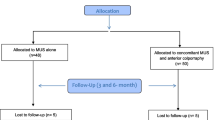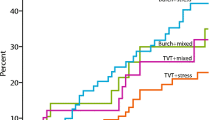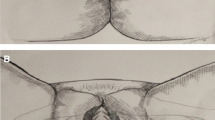Abstract
Introduction and hypothesis
The aim of this study was to compare the lower urinary tract symptom changes and surgical outcome between the tension-free vaginal tape (TVT) procedure with and without concomitant stage II pelvic organ prolapse (cystocele) repair in a randomized clinical trial setting.
Methods
Patients with urodynamically proven stress urinary incontinence (SUI) and asymptomatic stage II cystocele were randomly and equally allocated to either a TVT and concomitant cystocele repair group or TVT only group. SUI was corrected with TVT in all cases. The cystocele repair procedure was performed with Gynemesh®. Lower urinary tract symptoms and surgical outcome were assessed at postoperative year 1. Lower urinary tract symptoms were assessed with the American Urological Association Symptom Score (AUASS) questionnaire, uroflowmetry, and postvoid residual (PVR).
Results
The cure rate of TVT only and the concomitant repair group was 87 and 91 %, respectively (p > 0.05). Cystocele was cured in all patients in the concomitant repair group. After the operation, the total AUASS were 6.4 and 8.4 in the TVT only group and concomitant repair group, respectively, with no statistical difference. There was no difference in the change in peak flow rate (Qmax) and PVR between the two groups. The prevalence of postoperative mixed incontinence was not different between the two groups.
Conclusions
In patients with stage II cystocele and SUI, there was no difference in the surgical outcome and lower urinary tract symptoms between the TVT sling only group and concomitant repair group. Cystocele repair can be safely omitted in patients with stage II cystocele.

Similar content being viewed by others
References
Ng CS, Rackley RR, Appell RA (2001) Incidence of concomitant procedures for pelvic organ prolapse and reconstruction in women who undergo surgery for stress urinary incontinence. Urology 57(5):911–913
Morgan TO, Westney OL, McGuire EJ (2000) Pubovaginal sling: 4-year outcome analysis and quality of life assessment. J Urol 163(6):1845–1848
Wein AJ, Kavoussi LR, Novick AC, Partin AW, Peters CA (2007) Campbell-Walsh urology, 9th edn. Saunders Elsevier, Philadelphia, p 2255
Stamey TA (1980) Endoscopic suspension of the vesical neck for urinary incontinence in females. Report on 203 consecutive patients. Ann Surg 192(4):465–471
Chancellor MB, Rivas DA (1993) American Urological Association symptom index for women with voiding symptoms: lack of index specificity for benign prostate hyperplasia. J Urol 150(5):1706–1708
Lee YS, Han DH, Lim SH et al (2010) Efficacy and safety of “tension-free” placement of Gynemesh PS for the treatment of anterior vaginal wall prolapse. Int Neurourol J 14(1):34–42
Ballert KN, Kanofsky JA, Nitti VW (2008) Effect of tension-free vaginal tape and TVT-obturator on lower urinary tract symptoms other than stress urinary incontinence. Int Urogynecol J Pelvic Floor Dysfunct 19(3):335–340
Olsen AL, Smith VJ, Bergstrom JO, Colling JC, Clark AL (1997) Epidemiology of surgically managed pelvic organ prolapse and urinary incontinence. Obstet Gynecol 89(4):501–506
Paick JS, Cho MC, Oh SJ, Kim SW, Ku JH (2007) Factors influencing the outcome of mid urethral sling procedures for female urinary incontinence. J Urol 178(3):985–989
Deffieux X, Daher N, Mansoor A, Debodinance P, Muhlstein J, Fernandez H (2010) Transobturator TVT-O versus retropubic TVT: results of a multicenter randomized controlled trial at 24 months follow-up. Int Urogynecol J 21(11):1337–1345
Reich A, Kohorst F, Kreienberg R, Flock F (2011) Long-term results of the tension-free vaginal tape procedure in an unselected group: a 7-year follow-up study. Urology 78(4):774–777
Ignjatovic I, Stojkovic I, Basic D, Medojevic N, Potic M (2010) Optimal primary minimally invasive treatment for patients with stress urinary incontinence and symptomatic pelvic organ prolapse: tension free slings with colporrhaphy, or Prolift with the tension free midurethral sling? Eur J Obstet Gynecol Reprod Biol 150(1):97–101
Deffieux X, de Tayrac R, Huel C et al (2007) Vaginal mesh erosion after transvaginal repair of cystocele using Gynemesh or Gynemesh-Soft in 138 women: a comparative study. Int Urogynecol J Pelvic Floor Dysfunct 18(1):73–79
Acknowledgment
This paper was supported by Konkuk University in 2012.
Conflicts of interest
None.
Author information
Authors and Affiliations
Corresponding author
Rights and permissions
About this article
Cite this article
Park, H.K., Paick, S.H., Lho, Y.S. et al. Lack of effect of concomitant stage II cystocele repair on lower urinary tract symptoms and surgical outcome after tension-free vaginal tape procedure: randomized controlled trial. Int Urogynecol J 24, 1123–1126 (2013). https://doi.org/10.1007/s00192-012-1961-2
Received:
Accepted:
Published:
Issue Date:
DOI: https://doi.org/10.1007/s00192-012-1961-2




